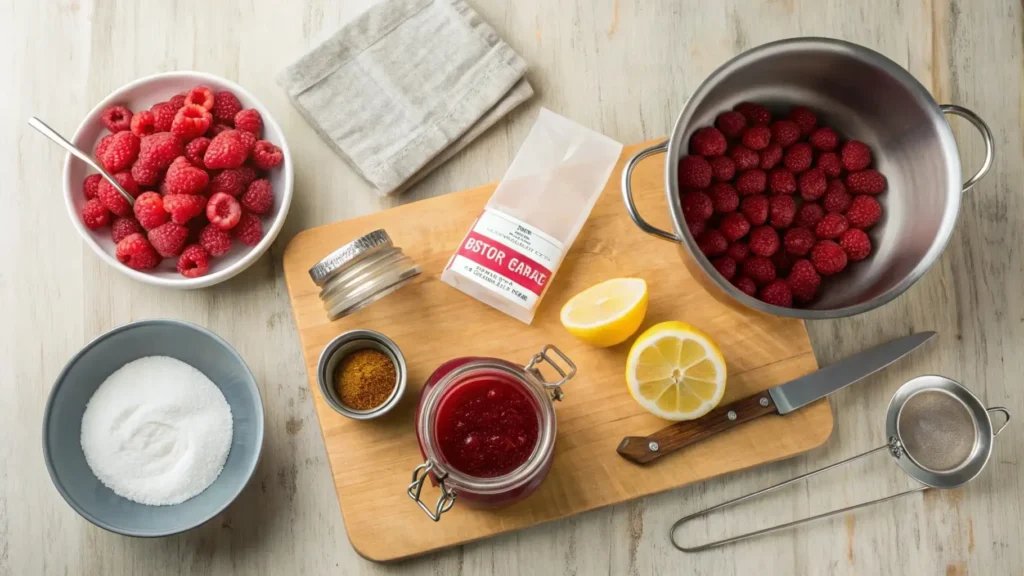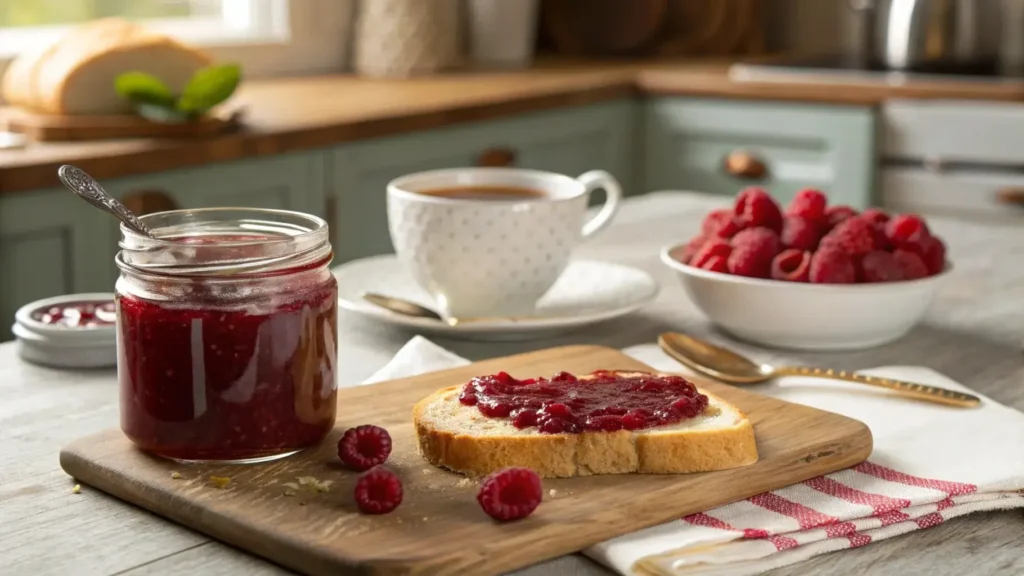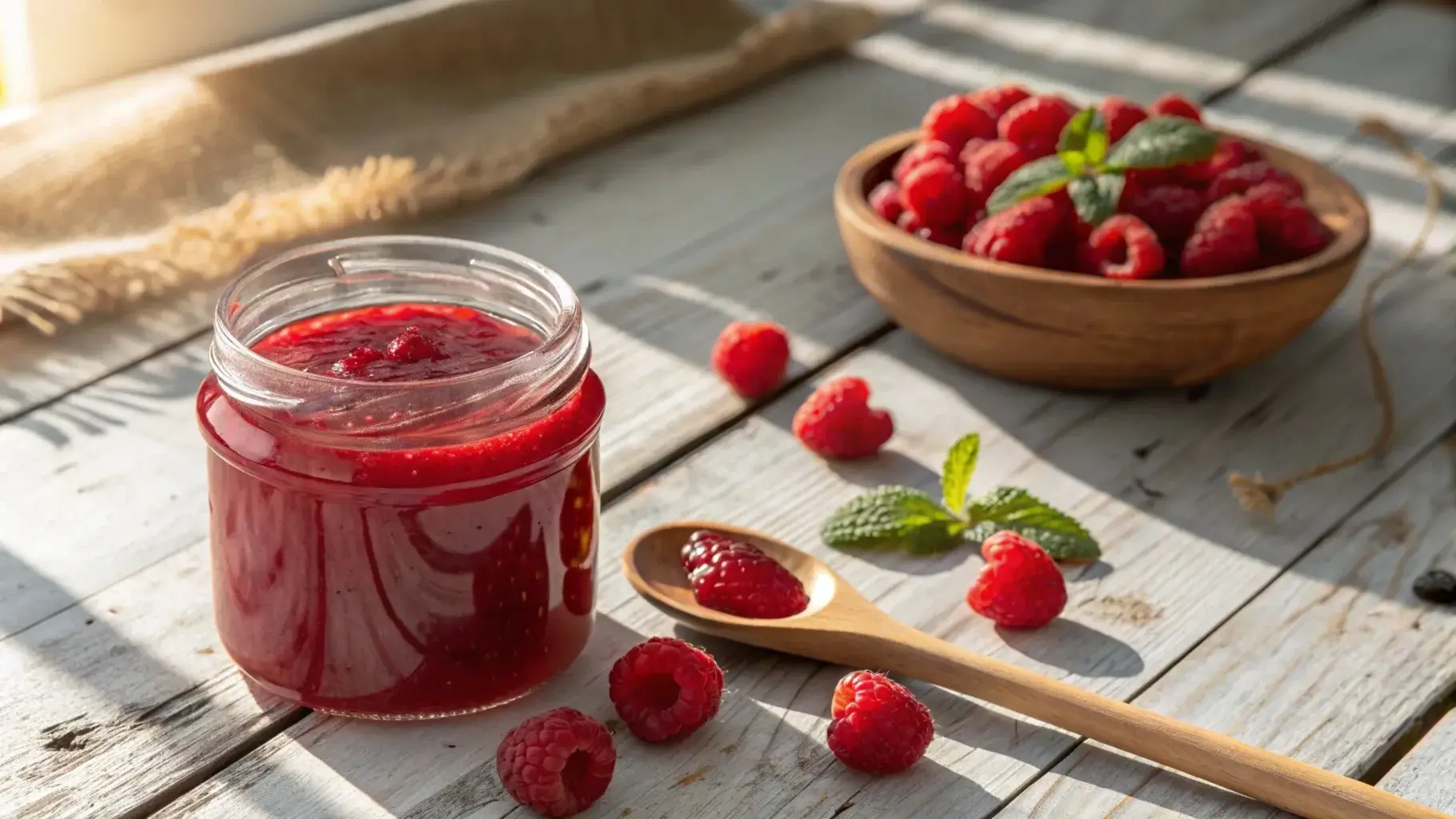There’s something magical about the sweet, tangy taste of raspberry jelly. Whether spread over freshly baked bread, drizzled on desserts, or used as a glaze, it brings a burst of flavor that’s hard to resist. This guide will take you through the world of raspberry jelly, from understanding its unique appeal to making it at home and exploring creative uses. We’ll dive into ingredients, tips, and even troubleshooting common issues, ensuring you have everything you need to enjoy this classic treat.
Table of contents
What Is Raspberry Jelly?
The Difference Between Jelly, Jam, and Preserves
Many people confuse jelly, jam, and preserves, but they each have unique qualities. Raspberry jelly is made by extracting the juice from raspberries, resulting in a smooth, clear spread with no fruit chunks. On the other hand, jam includes crushed fruit, giving it a thicker and more textured consistency. Preserves, as the name suggests, contain whole or large pieces of fruit suspended in a syrup or gel, making them heartier than jelly or jam.
The Unique Appeal
What makes raspberry jelly so special? For starters, its smooth texture spreads effortlessly, making it perfect for toast, pastries, and sandwiches. The flavor is bright and tangy, capturing the essence of fresh raspberries in every bite. Additionally, because it’s free of seeds or pulp, raspberry jelly is often preferred by those who enjoy a silky consistency without the crunch of fruit bits.
Historical and Culinary Uses
Interestingly, raspberry jelly has been enjoyed for centuries, with early recipes dating back to when preserving fruits was essential for survival. Over time, it evolved into a gourmet addition to sweet and savory dishes. Today, you’ll find it used in baking, glazing meats, and even in cocktails. Its versatility and rich history make it a staple in kitchens worldwide.

Ingredients and Tools for Making Raspberry Jelly
Essential Ingredients for Raspberry Jelly
Making raspberry jelly starts with a few simple yet essential ingredients. Of course, the star of the show is raspberries—fresh or frozen will work beautifully. You’ll also need sugar to sweeten and balance the tartness, as well as pectin or a natural thickening agent to achieve the perfect jelly consistency. Some recipes include lemon juice to enhance the flavor and help with the setting process. Altogether, these ingredients combine to create a smooth, delicious spread.
Choosing Between Fresh and Frozen Raspberries
When it comes to choosing raspberries, fresh berries are often preferred for their vibrant flavor and natural sweetness. However, frozen raspberries are just as effective, especially when fresh ones are out of season. Interestingly enough, frozen berries may even offer a stronger flavor because they’re picked and frozen at peak ripeness. No matter which you choose, ensure they are free from bruises, mold, or frostbite to maintain the jelly’s quality.
Necessary Tools for a Smooth Process
Having the right tools on hand makes creating raspberry jelly much easier. A large saucepan is essential for boiling the fruit and sugar mixture. For straining, use a jelly bag or cheesecloth to separate the juice from the seeds and pulp. You’ll also need sterilized jars for storing the finished product. Additionally, a candy thermometer helps monitor the temperature to ensure your jelly sets properly. With these tools ready, the process becomes straightforward and enjoyable.
How to Make Raspberry Jelly at Home
Step-by-Step Guide to Making It At Home
Making this recipe at home is both fun and rewarding. Here’s a simple guide to get you started:
- Prepare the raspberries: Rinse the berries thoroughly and mash them in a large bowl.
- Extract the juice: Place the mashed berries in a jelly bag or cheesecloth, letting the juice strain into a pot. This step is key to achieving a smooth jelly.
- Cook the mixture: Add sugar, pectin, and lemon juice to the raspberry juice and bring it to a boil, stirring constantly.
- Check the consistency: Use a candy thermometer to ensure the mixture reaches the gel stage (around 220°F).
- Pour and seal: Carefully ladle the hot jelly into sterilized jars, leaving some space at the top. Seal the jars and let them cool.
Tips for Achieving the Perfect Consistency
Getting the right texture can be tricky, but a few tips can help. First, always measure your ingredients accurately—too much sugar or too little pectin can affect the set. Second, don’t rush the cooking process. Let the mixture boil for the recommended time to ensure the jelly thickens. Finally, test the consistency by placing a small spoonful on a chilled plate. If it firms up, your jelly is ready!
Preservation Techniques: Canning and Storage
Proper storage is essential to enjoy your raspberry jelly for months. Use the canning method to extend its shelf life—this involves sealing the jars in a boiling water bath for 10–15 minutes. Store sealed jars in a cool, dark place, and refrigerate them after opening. When done correctly, homemade jelly can last up to a year!
Creative Variations of Raspberry Jelly
Spiced Raspberry Pepper Jelly
Adding a hint of spice to raspberry jelly creates a unique balance of sweet and savory flavors. Raspberry pepper jelly incorporates crushed red pepper flakes or jalapeños for a subtle heat that pairs perfectly with cheese and crackers. To make it, follow the standard jelly-making process but add chopped peppers during the cooking stage. Strain the mixture thoroughly to ensure a smooth texture. Additionally, this version works wonders as a glaze for grilled meats, adding a tangy kick to your dishes.
Sugar-Free and Low-Sugar Raspberry Jelly Options
For those who prefer a healthier option, sugar-free or low-sugar raspberry jelly is an excellent choice. By using natural sweeteners like stevia or honey, you can reduce the sugar content without compromising on flavor. Furthermore, some recipes use only the natural sweetness of the raspberries, making them ideal for those avoiding added sugars. Pectin is still crucial for achieving the right consistency, but be sure to use a low-sugar version for the best results.
Adding Other Fruits to Create Unique Flavors
Why stick to plain raspberry jelly when you can get creative? Mixing raspberries with complementary fruits like peaches, blackberries, or even apples adds depth and variety. For instance, a raspberry-apple jelly offers a delightful blend of tartness and sweetness, while a raspberry-blackberry combo creates a bold, berry-rich flavor. Moreover, these combinations make for stunning, jewel-toned jars that are as visually appealing as they are delicious.

Uses for Raspberry Jelly in Recipes
Baking with Raspberry Jelly: Cakes and Cupcakes
Raspberry jelly is a baker’s best friend, adding moisture and flavor to desserts. Use it as a filling for layer cakes or inject it into cupcakes for a delightful surprise. It also makes a quick and elegant glaze when brushed over fruit tarts or cheesecakes, enhancing both flavor and presentation.
Pairing Raspberry Jelly with Savory Dishes
Though traditionally sweet, raspberry jelly pairs beautifully with savory dishes. It can be used as a glaze for roasted chicken or pork, adding a hint of sweetness that balances out the savory notes. Spread a thin layer over a turkey sandwich to elevate your lunch, or combine it with balsamic vinegar for a unique salad dressing.
Innovative Snacks and Desserts Using Raspberry Jelly
For quick snacks, drizzle raspberry jelly over yogurt or oatmeal for a pop of color and flavor. It also works wonderfully as a dip for shortbread cookies or as a topping for pancakes and waffles. For a show-stopping dessert, layer jelly with whipped cream and crumbled biscuits in a glass for a simple yet stunning parfait.
For more culinary inspiration, check out The Ultimate Guide to Banana Chocolate Cake on Kamala Recipes, where you’ll find ideas to complement your jelly-making adventures
FAQs About Raspberry Jelly
What Is the Difference Between Raspberry Jam and Jelly?
The main difference between raspberry jam and raspberry jelly lies in their texture and preparation. To make jam, you crush the fruit, creating a thick and slightly chunky spread that includes seeds and fruit pieces. In contrast, you prepare jelly by extracting only the fruit juice, resulting in a smooth and clear spread without seeds or pulp. Many people prefer jelly for its silky texture, while others enjoy jam for its more robust, fruit-forward flavor.
How Do You Get the Seeds Out of Raspberries for Jelly?
To remove the seeds from raspberries for making jelly, use a jelly bag or cheesecloth. Start by mashing the raspberries and placing them in the jelly bag or a strainer lined with cheesecloth. Let the juice drip into a bowl, gently pressing the pulp with a spoon to extract as much liquid as possible. Avoid squeezing too hard, as this can force pulp or seeds through the strainer, compromising the jelly’s smooth texture.
Why Did Smuckers Stop Making Black Raspberry Jelly?
Smuckers discontinued its black raspberry jelly due to a combination of declining demand and challenges in sourcing black raspberries. This specific fruit has a limited harvest window and is less commonly grown compared to red raspberries, making it harder to produce on a large scale. Fans of black raspberry jelly can still make homemade versions using fresh or frozen black raspberries and following a traditional jelly recipe.
Is Raspberry Jam Anti-Inflammatory?
Raspberry jam can offer some anti-inflammatory benefits, though they may be reduced due to the sugar content and cooking process. Raspberries themselves are rich in antioxidants, including quercetin and ellagic acid, which have anti-inflammatory properties. However, consuming fresh or minimally processed raspberries is a better way to maximize these health benefits. If you’re looking for an anti-inflammatory spread, consider low-sugar raspberry jam or fresh raspberry purée.
Conclusion and Final Thoughts
Raspberry jelly is more than just a delicious spread—it’s a versatile and timeless addition to your kitchen repertoire. Whether you’re enjoying it on warm toast, using it to glaze meats, or adding it to your favorite desserts, its bright flavor and smooth texture make it a crowd-pleaser. Additionally, the process of making raspberry jelly is simple yet rewarding, allowing you to experiment with variations and create something truly unique.
From traditional recipes to creative twists, raspberry jelly offers endless possibilities. By learning the basics and mastering a few techniques, you can turn fresh or frozen raspberries into a flavorful treat that lasts for months. And with thoughtful pairings and recipe ideas, you’ll find countless ways to incorporate it into your meals and snacks.

So why not try making your own raspberry jelly today? With just a few ingredients and tools, you’ll have a homemade creation that’s as satisfying to make as it is to eat. Experiment with flavors, share your creations with loved ones, and enjoy the sweet success of a well-made jelly!

